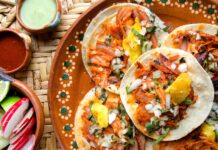When you hear the term “magic mushrooms” your mind probably goes to an illicit place —you might think about illegal drugs and some possibly bad decisions you made while studying abroad or in college. And you probably group these magic mushrooms in a category with other substances that you’re not supposed to take, and that you really don’t know much about. All of those judgments would be fair, and you’re not alone. But that’s a huge part of why author Michelle Janikian has written her book, Your Psilocybin Mushroom Companion: An Informative, Easy-to-Use Guide to Understanding Magic Mushrooms: From Tips and Trips to Microdosing and Psychedelic Therapy. Her book is a guide and an educational resource for anyone who is curious about the power of mushrooms, who wants to know how to use that power for good, and who is interested in the potential of these mysterious and magical natural substances.
Through extensive research as well as personal anecdotes Janikian has somehow answered all of the questions we didn’t even know we had where mushrooms are concerned. Where do these magic mushrooms come from? How long have they been around? How do they work? What does a trip feel like? How can they help us? How can we use them safely? Are they the future of modern medicine and self-care? There’s still so much we don’t know, but this book helps to address a lot of queries, uncover various truths, and share some seriously mind-blowing origins of magic mushrooms.
Experts and mushroom enthusiasts believe that mushrooms can encourage self-healing, spiritual growth, introspection, and can give people a “reset” both emotionally and spiritually. There’s also the potential for these magic mushrooms to help people cope with mental health issues like depression, anxiety, post-traumatic stress disorder (PTSD), addiction, and more. While the possibilities of positive impact are very real, it’s a complicated journey, because these psilocybin-containing mushrooms are still considered to be an illicit substance that is illegal to possess or consume in the US. This makes it difficult to conduct research and get any scientific proof of these potential benefits, and it also makes it challenging to consume mushrooms for healing in a safe, controlled setting. Janikian warns that it is crucial to get educated and to take certain precautions if you are looking to do mushrooms for restoration; she suggests you do your research (reading her book is a good place to start!) and seek out professionals to help you consume mushrooms successfully and safely.
Janikian’s hope is that her work will help to diminish the stigma surrounding mushroom use. After all, these magic fungi have been embraced by indigenous cultures for centuries as a part of spiritual journeys and sources of healing. The very least we can do is try to understand these origins and the potential purpose of these mushrooms in modern culture. So let’s dig in.
Magic Mushrooms Can Be Traced Back to Indigenous Cultures Throughout Central America
While you might find typical mushrooms growing in your backyard, in a nearby park or available for purchase at virtually every supermarket across the country, take note —those are not the kinds of magic mushrooms we are talking about here. Magic mushrooms are, well, magical, and these diverse species of fungi grow largely to the south of us, in Mexico.
Let’s back up a step; these mushrooms are “magical” (meaning they cause psychedelic effects in the form of a powerful trip) because they contain a mysterious substance called psilocybin. When psilocybin, a natural psychedelic alkaloid, is broken down in the body it becomes psilocin, which causes the psychedelic effects that we refer to as a trip. While this substance is found in over 180 species of mushrooms in nearly every corner of the globe, according to Janikian, the majority and most diverse species of these mushrooms grow in Mexico. To be more specific, there are an estimated 55 different species in Mexico alone, and there are possibly even more species of these mushrooms in Central and South America according to psilocybes expert Gastón Guzmán.
These mushrooms did not just pop up out of nowhere or appear in the 1960s when psychedelic drug use was at an all-time high in the US. In fact, they have been around for centuries and were used by indigenous people in Oaxaca, Mexico for thousands of years. Findings support those ancient Mayan territories in Guatemala and southern Mexico had a pre-Hispanic mushroom cult, and today those traditional ceremonies once practiced by ancient cultures are still maintained in indigenous villages throughout specific areas of Mexico explains Janikian.
In the eyes of those ancient cultures, not all mushrooms are created equal, but they are all sources of magical powers in their own ways. For example, the Mazatec people practice ceremonial use of these magic mushrooms in the Sierra Madre mountains of Oaxaca. According to Christopher Casuse, who has been working with the Mazatec for over a decade, “there are certain species that are more prized and coveted,” which is why different species of mushrooms are used for different ceremonial purposes. Some are used to elicit physical sensations, some for introspection, some for visual experience etc. But regardless of the specific purpose of the mushroom ceremony, what remains consistent is that the focus is not so much on the high, but on psilocybin’s safe and sacred powers.
The Truth About Ancient Mushroom Rituals
Not all members of these indigenous cultures were allowed to practice mushroom rituals, and not all were deemed qualified to be healers. The use of mushrooms for healing was seen as a process that was respected and sacred in Mazatec culture. And when mushrooms were consumed for healing, participants believed they were communicating with the “chikones,” who were protectors of the hills, rivers, caves, firsts, and mountains in the Sierra Mazateca region, explains Inti García Flores, a Mazatec man, and local professor in Oaxaca, in Janikian’s book.
Ancient mushroom rituals are not like what you might picture in terms of how pop culture depicts mushroom usage. While each ritual had its own style and purpose, Janikian explains that there were various common practices that were obeyed. They were practiced at night and only on certain days deemed more appropriate for healing or the desired effects. Some days were thought to be better for healing, and others better for communicating with the dead. There was always an altar in the ceremonial space. There were often candles and other symbolic objects that served as a link between the physical and spiritual worlds.
One important distinction Janikian makes between modern use (or misguided assumptions about what mushroom use is all about) and indigenous use of mushrooms is that in ancient cultures there was a lack of abuse. While psilocybin mushrooms aren’t addictive, you do still see misuse in modern civilization and modern drug culture. But misuse outside of ceremonial purposes in Mazatec communities is rare if not absent altogether. So why are mushrooms used inappropriately or unsafely in the 21stcentury, but in ancient traditions and indigenous cultures you rarely see substance abuse? Perhaps it’s a lack of knowledge or respect for the ancient, sacred use of these mushrooms, or it might be a misunderstanding about their purpose and history. Either way, when these magic mushrooms are not used in line with the indigenous traditions and rituals, things can feel bad and can go wrong, and when they do, they can go really wrong, Janikian warns.
After reading her illuminating book, we realized we still have several burning questions, so we sat down to chat with Michelle Janikian to discuss all things magic mushrooms, and get a little bit more insight on what inspired her to write this book, and how she seem magic mushrooms impacting the future of wellness and health.
What first inspired you to write this book about the power of magic mushrooms?
My first few mushroom trips were my inspiration to write the book. When I was a teen first trying magic mushrooms, I was totally unprepared for the magnitude of the experience and had no context for understanding the powerful event that ended up taking place. I took mushrooms without preparing myself or my setting and did some stupid and reckless things. Now that mushrooms have become very popular and more mainstream in the past few years with the decrim initiatives passing in Denver and Oakland and with Michael Pollan’s book, How to Change Your Mind, piquing all types of people’s curiosity in trying psychedelics like mushrooms, I thought there should be a complete guide that essentially translates all the safety info the psychedelic community takes for granted for a mainstream audience. If more people are going to be trying mushrooms than ever before, I wanted to make sure they didn’t make the same mistakes I did, and instead, I hope after reading the book, they take these powerful fungi responsibly “like adults” with great care and preparation. Basically, I wish a book like mine existed when I was first getting into psychedelics to help me use them more safely and intentionally.
How did your time traveling throughout Latin America, and now living in Mexico, help influence your perspective and educate you on the powers of mushrooms?
That’s a really good question. I’ve been living in Chiapas for over five years and indigenous culture is really strong here (although the locals here don’t use mushroom ceremonies to my knowledge). But I’ve learned a lot about indigenous healing ceremonies and indigenous spirituality of the Tzotzil Mayans in the nearby municipality of Chamula in these past few years. So when I started researching the Mazatec mushroom traditions up in Oaxaca, it made a lot of sense in a way that I don’t think I would have understood as well if I didn’t live here. To the Mazatec, mushrooms are incredibly sacred and highly revered, and I wanted to teach my readers a bit about their rituals surrounding mushroom ceremonies to really help them learn respect for the powerful and possibly spiritual experiences that mushrooms can elicit.
I was also really tired of the colonialist story of Gordon Wasson “discovering” magic mushrooms in the 1950s and that being the end of the indigenous story. I wanted to show people that these traditions are more than a sensational Life magazine article, that these are deeply ingrained parts of Mazatec society that should be respected, honored, and preserved.
I also wanted to show folks there are so many different ways to use mushrooms for healing outside the recently popularized Western medical approach of using magic mushrooms with a doctor/therapist. I wanted them to see that there are communities to this day that pre-date “psychedelic therapy” by centuries, possibly millennia, and their rituals are full of rich lessons to be learned about the sacredness and gravity of a mushroom experience.
How have ancient mushroom rituals embraced by indigenous cultures been preserved throughout time?
I think modern “psychonauts” —or those who use and enjoy psychedelics occasionally —already take indigenous traditions into account when approaching psychedelic trips. Many people from their own rituals and ceremonies, sometimes loosely based on indigenous tradition, to help create a “container” for the experience that then helps them process it and learn from it. I know many people who make altars in their homes to ground them during mushroom journeys even though that’s not a practice they were raised with. I even think modern clinical trials using psilocybin take some lessons from indigenous use, even if they have to tweak certain elements to standardize studies and maximize safety.
Do you think that in the future the potential of mushrooms will become a more mainstream form of modern medicine or self-care? Will mushrooms one day be considered in the same category as meditation and mindfulness?
Interesting! I think in certain circles, mushrooms are already very much a part of personal growth and self-care routines, as well as a spiritual practice. I also feel like a lot of folks who take mushrooms not really knowing what to expect come out with lessons that they need to take more time for self-care, and that they want to learn to connect with themselves and their communities on deeper levels through non-drug induced experiences, like meditation, mindfulness, yoga, breathwork, even therapy.
But it’s also a really exciting time for the decriminalization and de-stigmatization of psychedelics like mushrooms, so I think there could be a lot of interesting developments in the next few years. That said, I think a lot of researchers are a little bit afraid that widespread use could end up with some causalities and we could re-experience the prohibition that the 60s brought. But which again, is why the book’s like mine and other harm reduction organizations and events are so important, to help teach folks how to use these substances safely and responsibly. Then, hopefully, access can continue to expand.
Can anyone (and everyone) benefit from the spiritual and healing powers of mushrooms, or is it really more applicable to people with specific goals or physical and emotional needs?
I believe mushrooms are for everyone. There are certainly some people who will need to take some extra precautions around their mushroom use (like those with certain mental or physical health conditions), like enlisting a guide or sitter to help them through their trip and also support them in the days and weeks afterward. And I go into that a lot in the book to help people decide if that path is right for them.
But I don’t believe mushrooms should be exclusive to any one type of use, and my whole thing is to give people the tools they need to make their own decisions. Sure, folks with specific goals can take them, but I think what a lot of people find is that mushrooms bring up all sorts of feelings, memories, realizations, insights that were so far beyond what they were looking for. And I also don’t think mushrooms have to be exclusive to healing or personal growth, that even those who take them for fun or to connect with their friends and loved ones still end up having really significant and important experiences that can impact their lives or their way of thinking about things. It’s super specific to the individual, but I believe as long as people are safe and honest with themselves about their use, and they prepare themselves and take mushrooms in a safe environment, then they’re for everyone.
If readers take one thing away from your book, what do you hope they will learn, remember and pass on to others?
I just hope they take mushrooms safely and really give their whole experience a lot of thought. Like, prepare yourself, prepare your environment, prepare to have difficult things come up, prepare to feel a little raw the days and weeks following, prepare to integrate your experience. I also hope they remember that mushrooms can elicit really strong and significant, even sacred or spiritual experiences, and so it’s not something to be taken lightly, recklessly, or spontaneously. Just remember that mushrooms and the psychedelic experience should be respected, but if you’re thoughtful and responsible with your use, they can be great tools and powerful experiences that folks have been using to change their lives for centuries.
For Image credit or remove please email for immediate removal - info@belatina.com




































